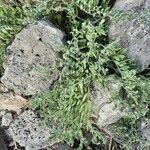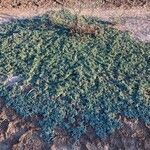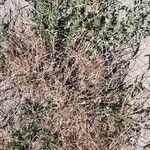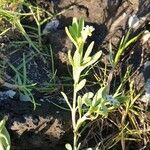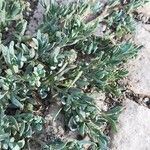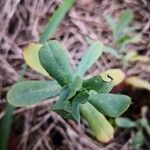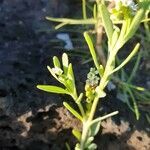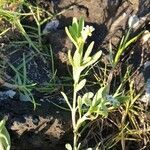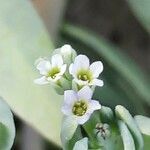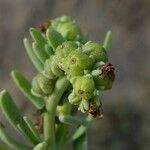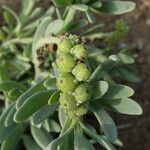Prostrate or decumbent annual or perennial fleshy herb, much branched, glaucous, quite glabrous. Leaves alternate or subopposite [as 'supposite'], 15-30(45) x 2-6 mm, narrowly oblong to narrowly obovate, rounded at apex, narrowed gradually to the base into a short petiole, entire, fleshy, slightly verrucous. Cymes moderately dense, ebracteate, slightly scorpioid, up to 8 cm long when completely expanded, single or 2, rarely to 4 on each short common peduncle, terminal. Flowers subsessile. Calyx c. 2 mm long, irregularly divided; tube none to as long as 1/3 of the calyx; lobes usually subequal, ovate to narrowly triangular, apex subacute to rounded, slightly inflexed. Corolla usually overlapping the calyx a little, salver-shaped, white; tube 1.5-2.0 mm long; lobes usually unequal, the largest one up to 1.0 mm long, triangular-ovate to oblong, rounded at apex. Stamens inserted at 1/3-1/2 of the corolla tube; anthers c. 0.8 mm long, narrowly ovoid, apiculate, subcordate at base, subsessile. Ovary ovoid. Style very short; stigma umbrella shaped without sterile appendix. Fruits c. 2 mm long, ± globulose; nutlets ovoid, free at maturity, with the outer surface rugose, the inner one with a ± circular cavity or a shell-shaped depression.
Herbs, prostrate, the stems 0.5 m long or longer, glabrous, succulent, some-times glaucous on the younger parts. Leaves alternate or somewhat fasciculate, oblanceolate, lanceolate, or spatulate, obtuse, entire, the bases attenuate, to 4 cm long and 1 cm wide, glabrous, succulent, somewhat glaucous; petioles indistinct. Inflorescences + spikes, unilateral, mostly terminal, ca 2-5 cm long, the bracts absent. Flowers sessile, + actinomorphic; calyx of 5 sepals, slightly connate basally, elongate-deltoid, ca 1.2-1.5 mm long; corolla salverform, white, the tube somewhat saccate, ca 1.2 mm long, each lobe ca 0.8 mm long; stamens 5, + sessile, the anthers ca 0.6-0.7 mm long; ovary 4-lobed, the disk obscure, the style absent, the stigma conical, annular-pubescent at the widened base. Fruit 4-lobed, separating into 4 nutlets at maturity, the nutlets glabrous, wedge-shaped, ca 1.6-1.7 mm long.
Glabrous perennial with scattered stems from stout creeping roots, somewhat fleshy, prostrate or decumbent, 2–5 dm; lvs linear or linear-oblanceolate, 1–4 cm × 2–5 mm; spikes seldom over 5 cm, the terminal ones usually paired on a peduncle, the lateral usually solitary and sessile or nearly so; cor 2–3.5 mm wide, white with a yellow eye; mature cal spreading; fr depressed-ovoid, 1.5–2.5 mm, soon splitting into 4 nutlets; 2n=26, 28. Native of tropical Amer., established as a weed, especially in saline soil, in s. U.S. n. to Del. and occasionally as a weed farther n. May–Sept. Ours are var. curassavicum. The well marked var. obovatum A. DC. (H. spathulatum) of interior w. U.S., with broader, more oblanceolate or even oblate lvs 6–18 mm wide and with the cor 5–9 mm wide, often with a purple eye, may possibly extend to w. Minn.
Annual, prostrate to ascending, more or less succulent herb. Stems much branched, 5-50 cm or more long, glabrous. Leaves shortly stalked to sessile, oblong, spathulate, lanceolate to linear, glaucous, 1-5 by 0.3-1 cm, glabrous. Cymes spike-like, 3-10 cm long, dense, ebracteate, usually forked once. Calyx subsessile, short, cleft to the base into 5 linear, acute lobes, glabrous. Corolla l-2.5(-3) mm long, white or bluish with a yellow centre, tube broadening towards base, longer or equalling the calyx, lobes 5, rounded. Stamens: anthers subsessile, sagittate, mucronate at apex. Pistil: style indistinct, stigma 0.2 mm long, with a broad, discoid base. Fruit breaking up into 4 nutlets; nutlets 1.6-1.8 mm long, wedge-shaped, smooth at first, later sometimes rugulose, glabrous.
Perennial, succulent herb. Stems annual, procumbent from a woody rootstock, glabrous; stems procumbent or erect (flowering branches), up to 0.5 m high. Leaves bluish green, sessile or blade decurrent; blade narrowly obovate, 10-65 x 1-13 mm, base cuneate, apex obtuse, margin entire, lower surface with undeveloped hairs. Flowers in helicoid cymes, ebracteate; upper part of style head discoid; calyx persistent, lobes triangular, shorter than corolla, ± 3 mm long in fruit; corolla with tube cylindrical, ± 2 mm long, naked in throat, lobes oblong, ± 1 mm long, apex rounded, white or light cream-coloured; Sep.-Apr. Fruit of nutlets, ± 2 mm long, glabrous, rugose.
Perennial herb with annual, succulent stems from a woody rootstock, glabrous. Stems procumbent or erect (flowering branches), up to 0.5 m high. Leaves sessile; blade narrowly obovate, decurrent, attenuate, bluish green. Flowers in helicoid cymes. Calyx shorter than corolla. Corolla white or light cream-coloured. Flowering time Sept.-Apr. Fruit of 4 glabrous, rugose nutlets.
A shrub. It lives for only a few years. It forms a mound. It grows 40 cm high and spreads 60 cm wide. The stems and leaves are fleshy. The leaves are narrow and sword shaped and 5 cm long. They are light green. The flowering stalk is at the ends of the plant. It can be 10 cm wide and is first cream but matures to purple.
Corolla usually overlapping the calyx a little, salver-shaped, white; tube 1.5–2.0 mm. long; lobes usually unequal, the largest one up to 1.0 mm. long, triangular-ovate to oblong, rounded at apex.
Leaves alternate or supposite, 15–30(45) x 2–6 mm., narrowly oblong to narrowly obovate, rounded at apex, narrowed gradually to the base into a short petiole, entire, fleshy, slightly verrucous.
Calyx c. 2 mm. long, irregularly divided; tube none to as long as; of the calyx; lobes usually subequal, ovate to narrowly triangular, apex subacute to rounded, slightly inflexed.
Prostrate or decumbent annual or perennial herb, fleshy, glabrous, glaucous. Leaves narrowly oblong to narrowly obovate. Corolla lobes triangular-ovate to oblong. Flowers white.
Fruits c. 2 mm. long, ± globulose; nutlets ovoid, free at maturity, with the outer surface rugose, the inner one with a ± circular cavity or a shell-shaped depression.
Erect or procumbent, annual or perennial halophyte, up to 500 mm tall. Leaves spathulate, bluish green, succulent. Flowers in a helicoid cyme, white. Nutlets rugose.
Cymes moderately dense, ebracteate, slightly scorpioid, up to 8 cm. long when completely expanded, single or 2, rarely to 4 on each short common peduncle, terminal.
Erect or prostrate, annual or perennial halophyte. Leaves spathulate, bluish green, succulent. Flowers in a helicoid cyme, white. Nutlets rugose.
Stamens inserted at 1/31/2 of the corolla tube; anthers c. 0.8 mm. long, narrowly ovoid, apiculate, subcordate at base, subsessile.
Prostrate or decumbent annual or perennial fleshy herb, much branched, glaucous, quite glabrous.
Style very short; stigma umbrella shaped without sterile appendix.
Flowers subsessile.
Ovary ovoid.
